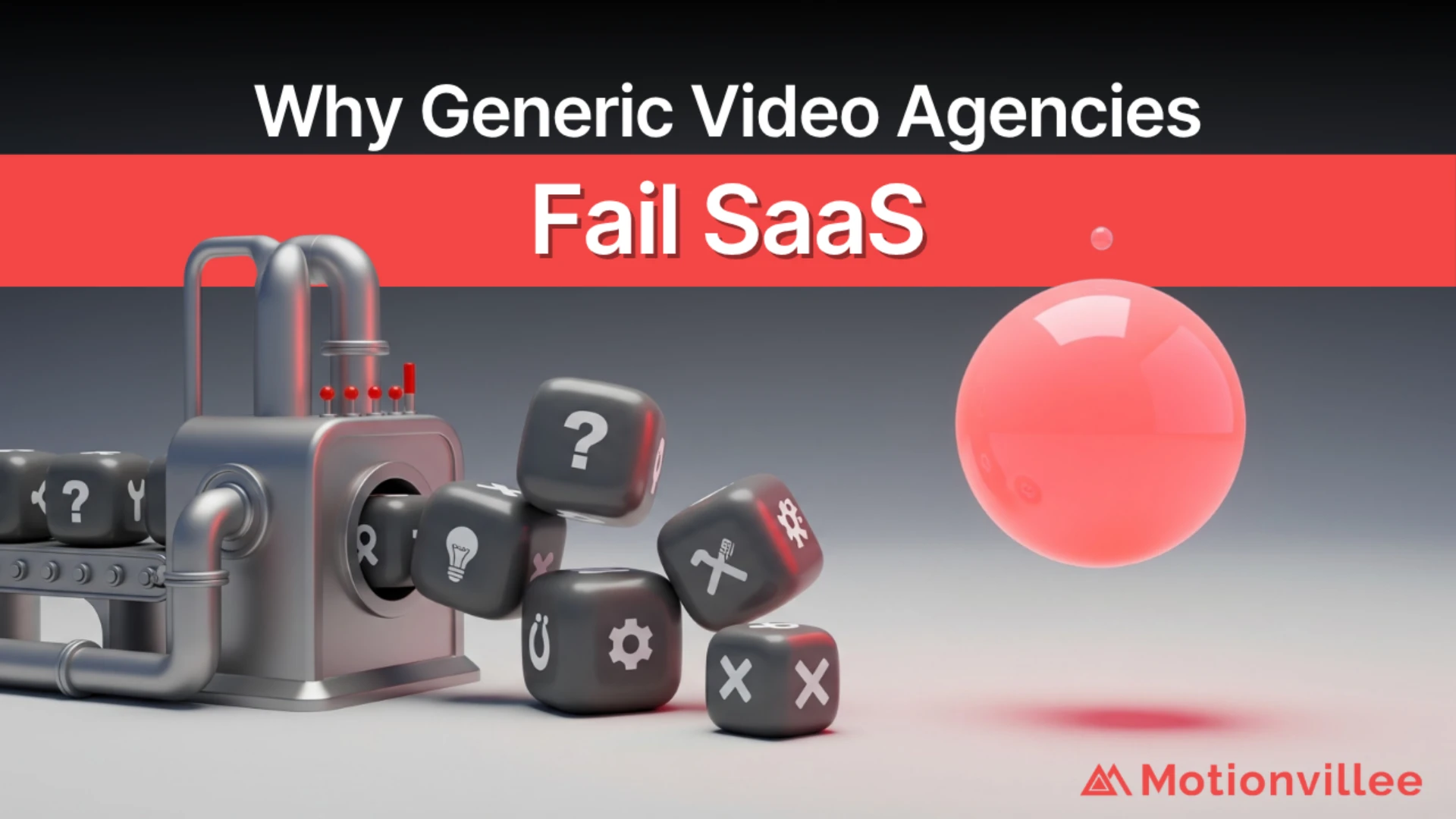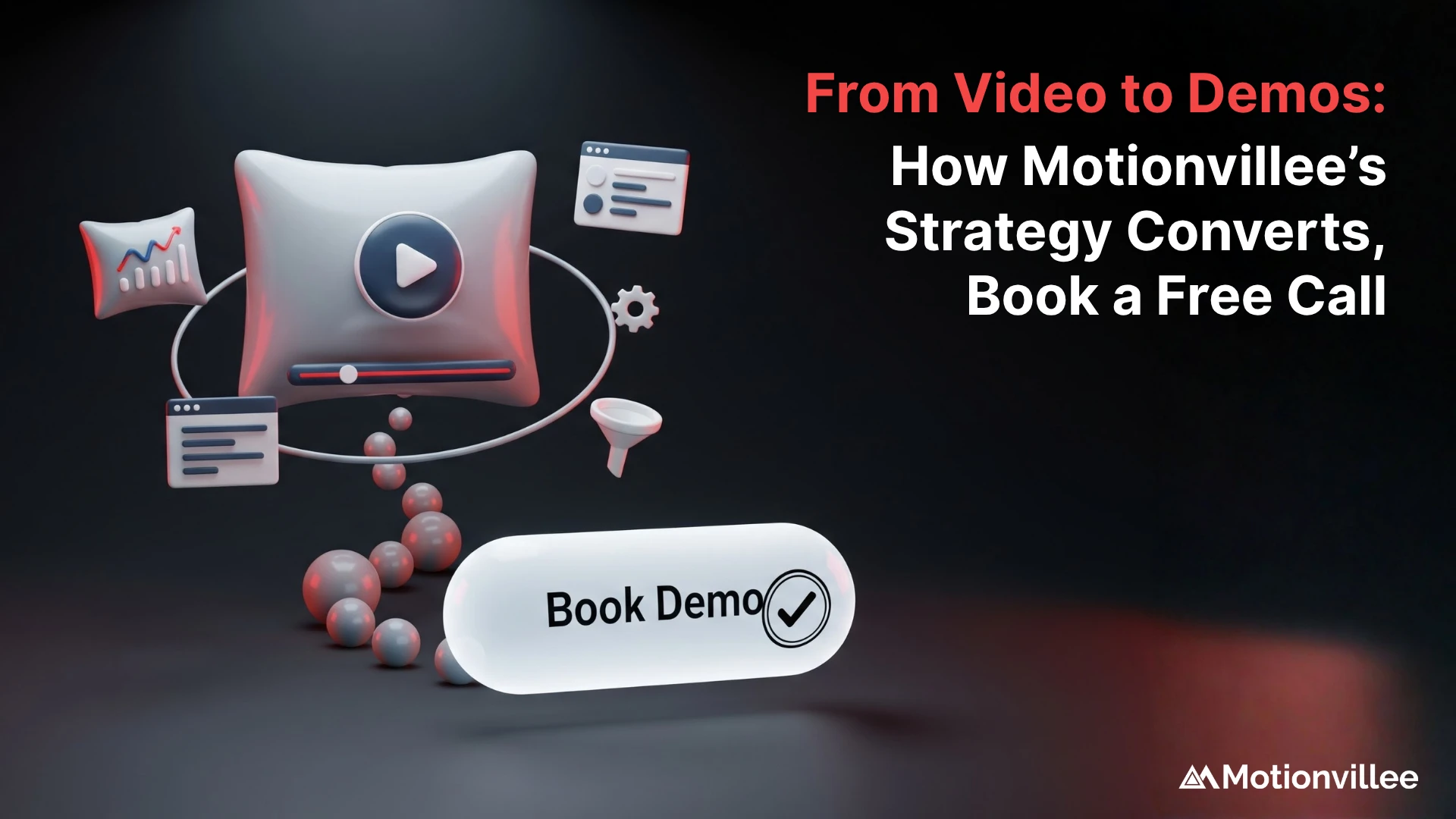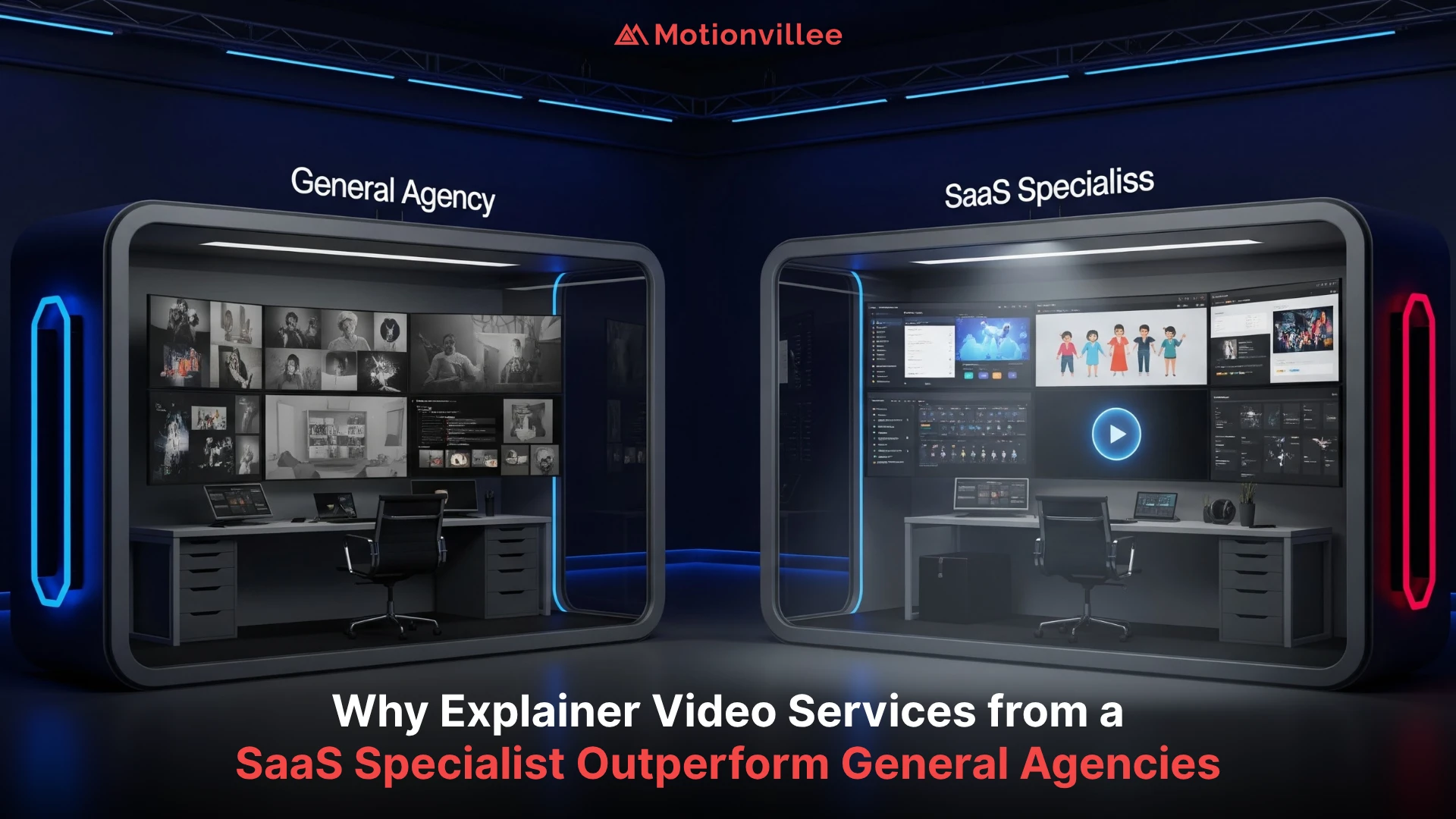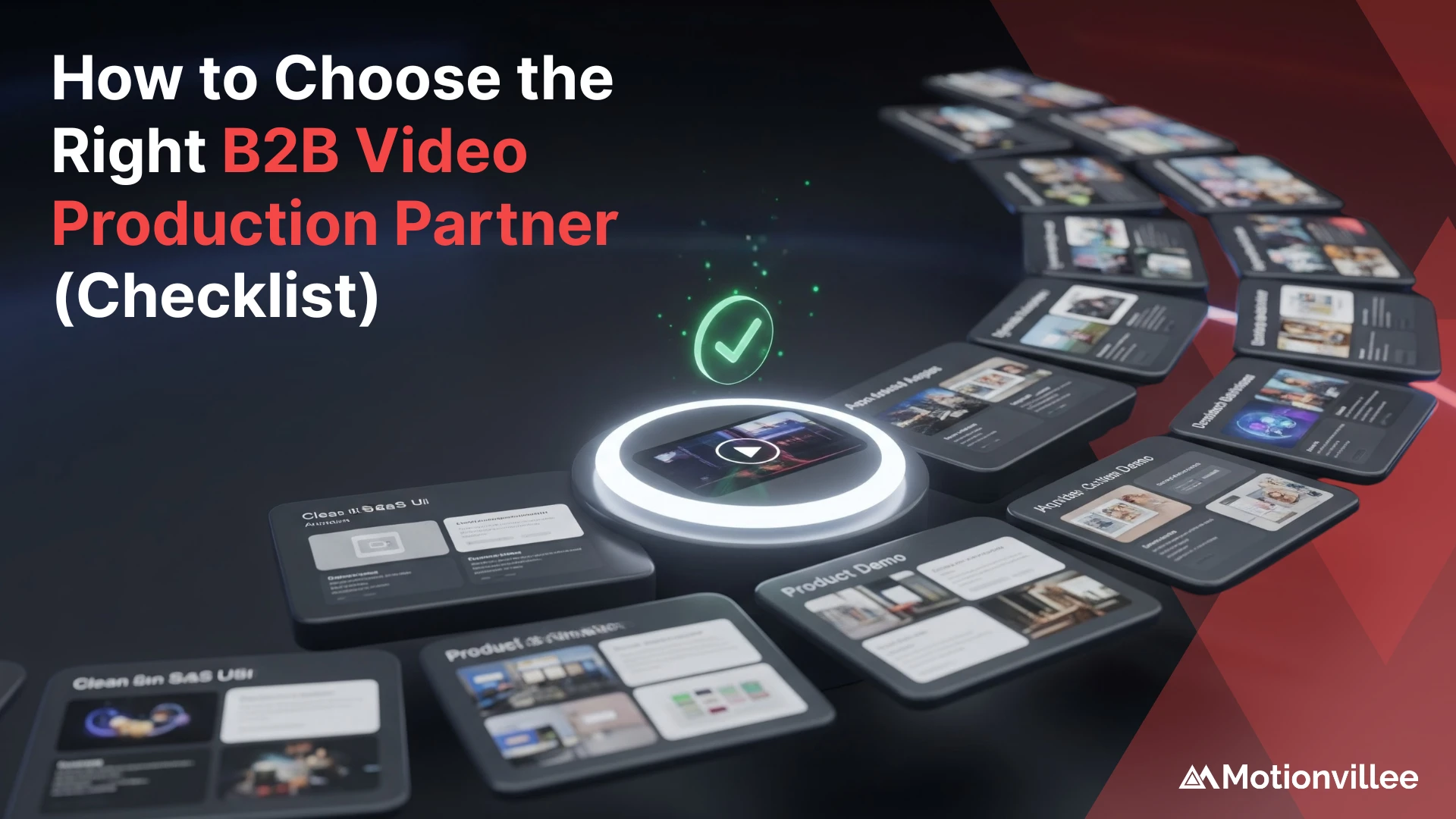Your Video Looked Great. It Just Didn’t Work.
You invested $30,000 in a professionally produced video. The visuals are stunning, the music is perfect, and your team loves it. But three months later, your demo requests haven’t increased, your sales team rarely uses it, and prospects still don’t understand what your product does.
This is the reality when you hire the wrong video agency. Generic production shops create beautiful content that fails to deliver results because they don’t understand how to make content work for SaaS businesses. The disconnect isn’t about creative talent. It’s about specialized knowledge.
Choosing the right partner requires understanding what separates effective partners from generic production shops. Here’s why most agencies fail at creating content that actually drives pipeline, and what you should look for instead.
Why Do Most Video Agencies Struggle With SaaS Products?
Most agencies lack experience with complex B2B products, long sales cycles, and technical buyers, so they apply consumer marketing approaches to enterprise software.
The fundamental difference between B2C and B2B strategy is outcome focus. Consumer content sells emotion and lifestyle. Enterprise software sells productivity, efficiency, and ROI. When agencies trained on consumer brands approach SaaS companies, they create emotionally driven content that looks impressive but doesn’t educate prospects about what your product actually does.
Product complexity requires specialized knowledge that general production shops don’t possess. Your software solves technical problems through sophisticated features. Explaining this clearly demands understanding the problem space, the user workflow, and the business impact. Generic video agency problems emerge when creative teams can’t grasp these technical concepts deeply enough to communicate them simply.
The conversion effectiveness gap:
Beautiful cinematography doesn’t compensate for unclear value propositions. Agencies can make your brand look modern and professional while completely failing to help prospects understand who your product is for, what problem it solves, or why it matters. The result is content that wins creative awards but generates zero pipeline.
Technical excellence without sales context becomes decoration rather than a business tool. Your prospects need education before they need inspiration. When agencies prioritize aesthetic appeal over clarity and demonstration, they’re optimizing for the wrong outcome entirely.
What Are the Warning Signs of a Generic Video Agency?
Generic agencies reveal themselves through their questions or lack thereof, their portfolio focus on brand content over education, and their inability to discuss funnel metrics.
Their portfolio tells you everything. When you see exclusively lifestyle content, brand films, and emotional storytelling without a single product demonstration or technical explanation, you’re looking at an agency that can’t handle complexity. Video production experience with consumer brands doesn’t translate to explaining software functionality.
Watch for these specific red flags:
- No questions about your sales process. They jump straight to creative concepts without understanding how prospects evaluate your product.
- Focus on viral potential instead of pipeline impact. They talk about views and shares rather than demo requests and conversion rates.
- Portfolio lacks B2B examples. Every case study shows consumer products or brand awareness campaigns.
- Can’t discuss conversion metrics. They have no framework for measuring business outcomes beyond engagement.
- Template based approach. They pitch the same video structure for every client regardless of product or audience.
- No understanding of product demo best practices. They’ve never considered how to show software workflows clearly.
- Creative first mentality. Every conversation starts with artistic vision rather than strategic objectives.
- Inability to articulate technical concepts. When you explain your product, they glaze over or simplify incorrectly.
Video production experience matters less than relevant experience. An agency with 50 consumer brand projects has less applicable knowledge than one with 10 B2B software projects. The skills don’t transfer as cleanly as agencies want to believe.
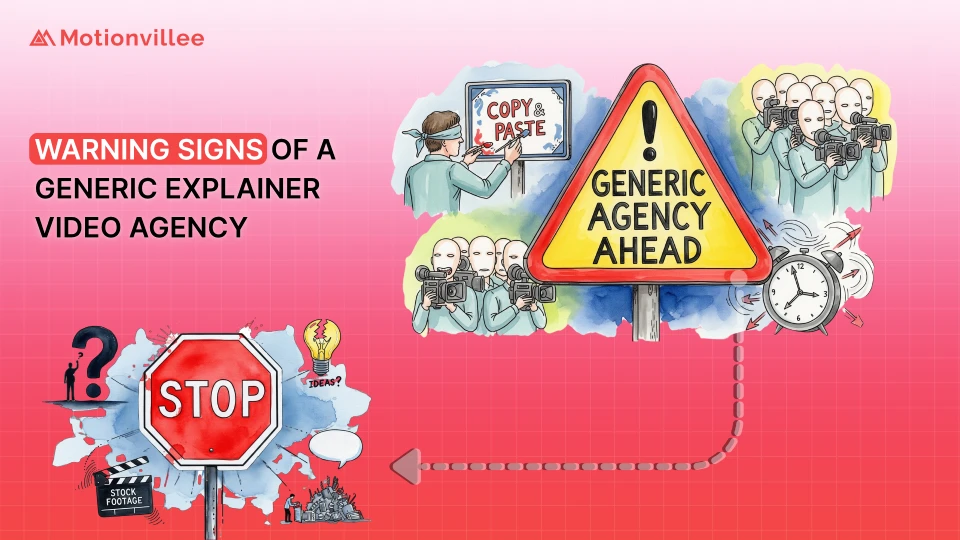
How Does the SaaS Buyer Journey Differ From Consumer Marketing?
The SaaS buyer journey involves multiple stakeholders, extended evaluation periods, and technical assessment, requiring content that educates and enables internal advocacy rather than just creating emotional response.
Multiple decision makers mean your content serves different audiences simultaneously. The technical evaluator needs to see architecture and integration capabilities. The business buyer needs ROI justification. The end user needs usability proof. B2B video must address all three without overwhelming any single viewer.
Education versus emotion in content strategy:
Consumer purchases happen quickly based on feeling. Enterprise software purchases happen slowly based on analysis. Your content can’t rely on emotional triggers alone. It must provide the technical depth and business case that B2B sales cycle decisions require
Content needs to support sales conversations, not replace them. Your prospects will discuss your solution internally with colleagues who never visit your website. Your content must travel well, meaning it needs to be clear enough that second hand descriptions remain accurate. Brand storytelling doesn’t enable this internal advocacy. Clear demonstration does.
Technical buyers evaluate content with skepticism. They’re looking for accuracy, depth, and proof of capability. Flashy creative that skips technical substance signals superficiality. These buyers need to see actual functionality, not metaphorical representations or abstract concepts.
Feature demonstration beats brand storytelling in B2B contexts because purchase decisions hinge on capability verification. Prospects aren’t wondering if they’ll feel good using your software. They’re wondering if it solves their specific technical problem.
What Specific SaaS Knowledge Should Your Video Partner Have?
Effective partners understand product complexity, technical documentation, user workflows, and how to translate features into business outcomes for non technical buyers.
Experience explaining technical products simply is the core competency. Your partner needs to absorb complex information quickly, identify what matters most to buyers, and communicate it without oversimplifying. This skill separates specialized SaaS video agency capabilities from generic production.
Essential knowledge areas your partner must possess:
Understanding of metrics and business models matters because your content needs to speak the language of your buyers. Agencies should grasp concepts like MRR, churn, CAC, and LTV without explanation. Technical product video creation requires this foundational business literacy.
Knowledge of typical sales cycles informs content strategy. When your partner understands that enterprise deals take 6-12 months with multiple touchpoints, they create content that serves each stage appropriately rather than trying to force immediate decisions.
Familiarity with product led growth versus sales led approaches shapes execution. The content requirements differ dramatically between these models, and agencies need to recognize which approach your business uses.
Working effectively with technical teams:
Your engineers and product managers hold the knowledge that must translate into content. Partners need the ability to interview technical teams, extract key information, and translate it accurately without getting lost in implementation details that don’t serve buyer education.
Understanding of security, compliance, and enterprise concerns ensures content addresses real buying objections. When your prospects need SOC 2 compliance or GDPR adherence, your content should acknowledge these requirements naturally rather than treating them as afterthoughts.
Why Do Beautiful Videos Sometimes Fail to Convert?
Visual appeal doesn’t guarantee effectiveness because content optimized for creative awards often sacrifices clarity, education, and conversion optimization.
The disconnect between creative excellence and business results happens when agencies optimize for peer recognition rather than customer outcomes. B2B video marketing that wins festival awards frequently confuses actual buyers because artistic expression trumped clear communication.
Why brand films rarely drive pipeline:
Emotional brand content works for consumer products where feeling drives purchase. Enterprise software requires rational justification. When your content focuses on mood, atmosphere, and brand personality without demonstrating product capability, you’re creating content for the wrong buying process.
Excessive creativity obscures product value when metaphors and abstract concepts replace clear demonstration. If prospects finish watching and still can’t articulate what your product does, your content failed regardless of production quality. SaaS marketing video must prioritize understanding over impression.
The clarity versus artistry tradeoff:
Sometimes you must choose between a beautiful shot and a clear explanation. Specialized partners choose clarity. Generic agencies choose beauty. This fundamental priority difference determines whether your content drives business outcomes or just looks impressive in your portfolio.
Education should trump entertainment in B2B contexts. Your prospects aren’t looking for content to enjoy. They’re looking for information to evaluate. When agencies treat your product demo like a Super Bowl commercial, they’re applying the wrong creative framework entirely.
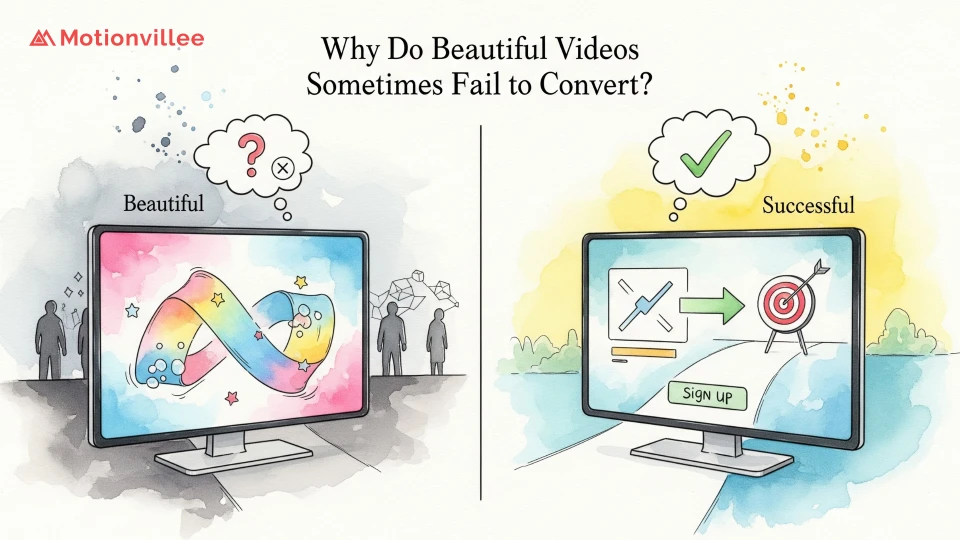
What Questions Should You Ask Before Hiring a Video Agency?
The right questions reveal whether a video agency for SaaS understands your market or just makes pretty content.
Ask about their process for understanding technical products. If they can’t articulate a discovery methodology that includes technical interviews, buyer research, and competitive analysis, they’re winging it. Choose video agency SaaS partners who demonstrate systematic approaches to learning complex products.
Essential questions about experience and approach:
- How many B2B software companies have you worked with? Specific numbers and examples matter more than vague claims.
- Can you show me three product demos you’ve created? Evaluate their ability to explain technical functionality clearly.
- How do you approach learning unfamiliar technical concepts? Their answer reveals intellectual curiosity and learning methods.
- What questions do you typically ask during discovery? This shows whether they investigate deeply or accept surface explanations.
- How do you measure success for clients? Look for business metrics, not creative awards.
- What experience do you have with sales enablement content? Your sales team’s adoption signals real effectiveness.
- How do you ensure technical accuracy? Mistakes damage credibility with technical buyers.
- What’s your revision process look like? Multiple stakeholders mean complex feedback loops.
- How do you approach different funnel stages? One size fits all thinking signals inexperience.
- Can you walk me through a recent project from brief to delivery? This reveals their actual process, not their idealized pitch.
Video agency questions like these separate partners who understand your business from vendors who just execute creative briefs. Video agency selection should prioritize strategic thinking over portfolio aesthetics.
How Should SaaS Video Strategy Differ by Funnel Stage?
Top of funnel needs clarity and awareness, mid funnel needs education and differentiation, and bottom funnel needs proof and specificity.
Generic agencies treat all content the same way, but SaaS video strategy requires matching content type to buyer readiness. A prospect discovering your category needs different information than one comparing final vendors.
Stage specific content requirements:
- Top of funnel focuses on problem identification and solution category education. Your SaaS video here should help prospects recognize they have a problem worth solving and that software solutions exist. Product specifics come later.
- Mid funnel delivers education and product demonstration. This is where product demo video becomes essential. Prospects understand their problem and now evaluate which solution fits best. Clear workflow demonstrations and feature explanations belong here.
- Bottom of funnel provides proof and addresses specific objections. Customer testimonials, security documentation, implementation details, and pricing justification help close deals. Content must answer the final questions blocking purchase decisions.
- Post purchase content supports onboarding and feature adoption. Tutorial content, best practices, and advanced feature education reduce time to value and increase retention. This stage is often neglected but drives lifetime value.
One size fits all thinking fails because prospects at different stages need fundamentally different information. Content that works beautifully for awareness confuses prospects ready to buy, and vice versa.
What Does a Strong SaaS Video Portfolio Look Like?
A strong portfolio shows successful explainer videos, product demos, customer testimonials with specific results, and technical content that remains clear.
Look for diversity in complexity levels within the video agency portfolio. Can they explain simple tools and complex enterprise platforms? Range demonstrates adaptability. Video agency for SaaS companies should showcase work across different product types and technical depths.
Portfolio evaluation criteria:
Types that indicate expertise include homepage explainers that achieve clarity in under 90 seconds, product demos that show actual software workflows without confusion, customer stories that cite specific metrics rather than vague praise, and technical deep dives that remain accessible to business buyers.
The SaaS explainer video examples should make you understand unfamiliar products quickly. If you watch their portfolio and still can’t explain what those companies do, they’re not communicating clearly. Your prospects will have the same experience.
Red flags in agency work:
Every piece looks identical in structure and pacing. This signals template thinking rather than custom strategy. All content focuses on brand and emotion with minimal product demonstration. Beautiful cinematography that tells you nothing about what the product actually does. Vague benefits without concrete use cases or outcomes.
Questions to ask about case studies include what specific metrics improved, how the client uses the content in their sales process, whether the sales team actually adopted it, and what revisions were required during production. Honest answers reveal real effectiveness versus marketing claims.
Vertical experience matters because fintech buyers differ from cybersecurity buyers who differ from HR tech buyers. Agencies with relevant vertical experience understand the specific concerns, compliance requirements, and buying patterns of your market.
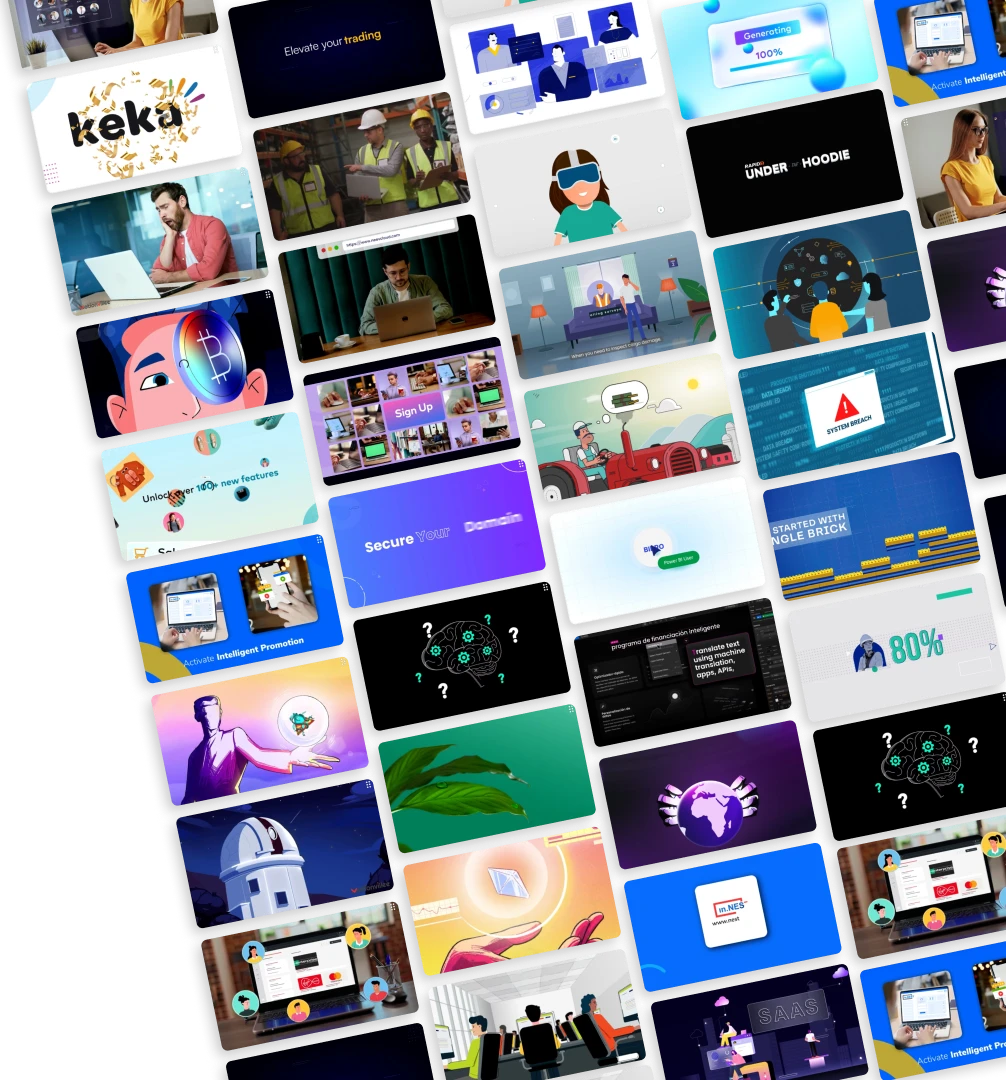
How Do Specialized SaaS Agencies Approach Projects Differently?
Specialized agencies start with strategy, deeply understand your product and buyers, collaborate with your sales team, and optimize for business metrics rather than creative recognition.
The SaaS video production partner discovery process should feel rigorous. Expect detailed questionnaires, stakeholder interviews, competitive analysis, and buyer persona development before creative concepts emerge. This upfront investment prevents expensive revisions later.
How they work with your team:
Technical team collaboration involves structured interviews where agencies extract key information without requiring your engineers to become marketers. Effective partners ask the right questions to surface what matters to buyers, not just what’s technically impressive about your architecture.
Script development emphasizes clarity testing. Before production begins, specialized agencies validate that your team, your sales reps, and ideally some prospects actually understand the message. This prevents discovering communication failures after expensive production.
Focus on measurable outcomes:
Conversion optimization thinking permeates every decision. Camera angles, pacing, information sequencing, and calls to action all serve business goals. The sales enablement video integration ensures content actually gets used by your team rather than sitting unused in a marketing folder.
Measurement and iteration separate partners from vendors. SaaS video production should include defined success metrics, tracking implementation, and willingness to refine based on performance data. Agencies that deliver and disappear can’t improve results over time.
Effective SaaS video comes from understanding your business as deeply as understanding production. Technical skills matter, but strategic thinking about your market, your buyers, and your sales process matters more.
What ROI Should You Expect From SaaS Video Content?
Well executed content delivers measurable improvements in demo requests, sales cycle length, deal velocity, and customer onboarding efficiency.
Realistic conversion rate improvements for homepage content range from 20-40% increases in demo requests when you replace text heavy explanations with clear demonstrations. Video conversion metrics should be tracked from day one to validate effectiveness.
Measurable business impact:
Sales cycle compression typically achieves 25-35% reduction in time to close when prospects arrive at conversations already educated about your product. Your team spends less time on basic explanation and more time on strategic fit.
Sales efficiency improves because your best explanation scales infinitely. One excellent product demo watched by thousands of prospects delivers more consistent messaging than hundreds of individual sales calls with variable quality.
Customer success metrics improve when onboarding content reduces time to value. Customers who watch tutorial content adopt features 40-60% faster than those who don’t, reducing support burden and increasing retention.
Why generic agencies avoid metrics discussions:
They can’t articulate SaaS video ROI because they don’t track it. Their success metrics are creative awards, festival selections, and client testimonials about how much they enjoyed working together. None of these correlate with business outcomes.
Measuring properly requires defining objectives upfront, implementing tracking, comparing performance before and after, and attributing results accurately. Specialized partners embrace this accountability because they know their work delivers measurable value.
Generic agencies resist measurement because their content often fails to move business metrics despite looking impressive. When you ask about ROI and get vague answers about brand awareness, you’re talking to the wrong partner.
Choose a Partner Who Understands Your Business, Not Just Video
Generic agencies fail because they lack knowledge about how to create content that works in B2B contexts.
The cost of beautiful but ineffective content extends beyond wasted production budget. You lose the opportunity cost of time that could have been spent on content that actually drives pipeline. You waste your team’s time in production. You potentially confuse prospects with unclear messaging.
Specialized knowledge is the differentiator. Technical understanding, strategic thinking, and measurement discipline matter more than cinematography skills. The right partner treats your content as a business tool, not an art project.
Your product deserves a partner who will invest time understanding your market, your buyers, and your business model before touching a camera. This strategic foundation determines whether your content drives growth or just looks impressive in isolation.
Ready to work with a partner who understands both video production and business growth? Schedule a call with Motionvillee to discuss how we approach content specifically for B2B software companies. We’ll show you the difference between generic production and strategic partnership.


